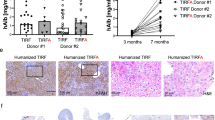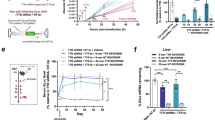Abstract
Interferons control viral replication and the growth of some malignant tumors. Since systemic application may cause severe adverse effects, tissue-specific expression is an attractive alternative. Liver-directed interferon gene therapy offers promising applications such as chronic viral hepatitis B or C or hepatocellular carcinoma and thus needs testing in vivo in suitable animal models. We therefore used the Tet-On system to regulate gene expression in adenoviral vectors, and studied the effect of liver-specific and regulated interferon γ expression in a mouse model of chronic hepatitis B virus (HBV) infection. In a first generation adenoviral vector, genes encoding for firefly luciferase and interferons α, β or γ, respectively, were coexpressed under control of the bidirectional tetracycline-regulated promoter Ptetbi. Liver-specific promoters driving expression of the reverse tetracycline controlled transactivator ensured local expression in the livers of HBV transgenic mice. Following gene transfer, we demonstrated low background, tight regulation and a 1000-fold induction of gene expression by doxycycline. Both genes within the bidirectional transcription unit were expressed simultaneously, and in a liver-specific fashion in cell culture and in living mice. Doxycycline-dependent interferon γ expression effectively controlled HBV replication in mice, but did not eliminate HBV transcripts. This system will help to study the effects of local cytokine expression in mouse disease models in detail.
This is a preview of subscription content, access via your institution
Access options
Subscribe to this journal
Receive 12 print issues and online access
$259.00 per year
only $21.58 per issue
Buy this article
- Purchase on Springer Link
- Instant access to full article PDF
Prices may be subject to local taxes which are calculated during checkout





Similar content being viewed by others
References
Guidotti LG et al. Intracellular inactivation of the hepatitis B virus by cytotoxic T lymphocytes. Immunity 1996; 4: 25–36.
Cavanaugh VJ, Guidotti LG, Chisari FV . Interleukin-12 inhibits hepatitis B virus replication in transgenic mice. J Virol 1997; 71: 3236–3243.
Kimura K et al. Interleukin-18 inhibits hepatitis B virus replication in the livers of transgenic mice. J Virol 2002; 76: 10702–10707.
Frese M et al. Interferon-gamma inhibits replication of subgenomic and genomic hepatitis C virus RNAs. Hepatology 2002; 35: 694–703.
Protzer U et al. Interferon gene transfer by a hepatitis B virus vector efficiently suppresses wild-type virus infection. Proc Natl Acad Sci USA 1999; 96: 10818–10823.
Gossen M, Bujard H . Tight control of gene expression in mammalian cells by tetracycline-responsive promoters. Proc Natl Acad Sci USA 1992; 89: 5547–5551.
Gossen M et al. Transcriptional activation by tetracyclines in mammalian cells. Science 1995; 268: 1766–1769.
Baron U, Freundlieb S, Gossen M, Bujard H . Co-regulation of two gene activities by tetracycline via a bidirectional promoter. Nucleic Acids Res 1995; 23: 3605–3606.
Kistner A et al. Doxycycline-mediated quantitative and tissue-specific control of gene expression in transgenic mice. Proc Natl Acad Sci USA 1996; 93: 10933–10938.
Hasan MT et al. Long-term, noninvasive imaging of regulated gene expression in living mice. Genesis 2001; 29: 116–122.
Urlinger S et al. Exploring the sequence space for tetracycline-dependent transcriptional activators: novel mutations yield expanded range and sensitivity. Proc Natl Acad Sci USA 2000; 97: 7963–7968.
Baron U, Bujard H . Tet repressor-based system for regulated gene expression in eukaryotic cells: principles and advances. Methods Enzymol 2000; 327: 401–421.
Gossen M, Bujard H . Studying gene function in eukaryotes by conditional gene inactivation. Annu Rev Genet 2002; 36: 153–173.
Molin M et al. Two novel adenovirus vector systems permitting regulated protein expression in gene transfer experiments. J Virol 1998; 72: 8358–8361.
Corti O et al. A single adenovirus vector mediates doxycycline-controlled expression of tyrosine hydroxylase in brain grafts of human neural progenitors. Nat Biotechnol 1999; 17: 349–354.
Rubinchik S et al. Adenoviral vector which delivers FasL-GFP fusion protein regulated by the tet-inducible expression system. Gene Therapy 2000; 7: 875–885.
Aurisicchio L et al. Regulated and prolonged expression of mIFN(alpha) in immunocompetent mice mediated by a helper-dependent adenovirus vector. Gene Therapy 2001; 8: 1817–1825.
Haberman RP, McCown TJ, Samulski RJ . Inducible long-term gene expression in brain with adeno-associated virus gene transfer. Gene Therapy 1998; 5: 1604–1611.
Fitzsimons HL, McKenzie JM, During MJ . Insulators coupled to a minimal bidirectional tet cassette for tight regulation of rAAV-mediated gene transfer in the mammalian brain. Gene Therapy 2001; 8: 1675–1681.
Rendahl KG et al. Tightly regulated long-term erythropoietin expression in vivo using tet-inducible recombinant adeno-associated viral vectors. Hum Gene Ther 2002; 13: 335–342.
Paulus W et al. Self-contained, tetracycline-regulated retroviral vector system for gene delivery to mammalian cells. J Virol 1996; 70: 62–67.
Hofmann A, Nolan GP, Blau HM . Rapid retroviral delivery of tetracycline-inducible genes in a single autoregulatory cassette. Proc Natl Acad Sci USA 1996; 93: 5185–5190.
Reiser J, Lai Z, Zhang XY, Brady RO . Development of multigene and regulated lentivirus vectors. J Virol 2000; 74: 10589–10599.
Kafri T, van Praag H, Gage FH, Verma IM . Lentiviral vectors: regulated gene expression. Mol Ther 2000; 1: 516–521.
Ho DY, McLaughlin JR, Sapolsky RM . Inducible gene expression from defective herpes simplex virus vectors using the tetracycline-responsive promoter system. Brain Res Mol Brain Res 1996; 41: 200–209.
He TC et al. A simplified system for generating recombinant adenoviruses. Proc Natl Acad Sci USA 1998; 95: 2509–2514.
Steinwaerder DS, Lieber A . Insulation from viral transcriptional regulatory elements improves inducible transgene expression from adenovirus vectors in vitro and in vivo. Gene Therapy 2000; 7: 556–567.
Rubinchik S et al. Creation of a new transgene cloning site near the right ITR of Ad5 results in reduced enhancer interference with tissue-specific and regulatable promoters. Gene Therapy 2001; 8: 247–253.
Talbot D, Descombes P, Schibler U . The 5′ flanking region of the rat LAP (C/EBP beta) gene can direct high-level, position-independent, copy number-dependent expression in multiple tissues in transgenic mice. Nucleic Acids Res 1994; 22: 756–766.
Schönig K, Schwenk F, Rajewsky K, Bujard H . Stringent doxycycline dependent control of CRE recombinase in vivo. Nucleic Acids Res 2002; 30: 134.
Costa RH, Grayson DR . Site-directed mutagenesis of hepatocyte nuclear factor (HNF) binding sites in the mouse transthyretin (TTR) promoter reveal synergistic interactions with its enhancer region. Nucleic Acids Res 1991; 19: 4139–4145.
Schulze-Bergkamen H et al. Primary human hepatocytes - a valuable tool for investigation of apoptosis and hepatitis B virus infection. J Hepatol 2003; 38: 736–744.
Gallagher AR et al. Use of the tetracycline system for inducible protein synthesis in the kidney. J Am Soc Nephrol 2003; 14: 2042–2051.
Contag CH et al. Visualizing gene expression in living mammals using a bioluminescent reporter. Photochem Photobiol 1997; 66: 523–531.
Agha-Mohammadi S, Lotze MT . Regulatable systems: applications in gene therapy and replicating viruses. J Clin Invest 2000; 105: 1177–1183.
Clackson T . Regulated gene expression systems. Gene Therapy 2000; 7: 120–125.
Ilan Y, Saito H, Thummala NR, Chowdhury NR . Adenovirus-mediated gene therapy of liver diseases. Semin Liver Dis 1999; 19: 49–59.
Breyer B et al. Adenoviral vector-mediated gene transfer for human gene therapy. Curr Gene Ther 2001; 1: 149–162.
Harding TC et al. Switching transgene expression in the brain using an adenoviral tetracycline-regulatable system. Nat Biotechnol 1998; 16: 553–555.
Johansen J et al. Evaluation of Tet-on system to avoid transgene down-regulation in ex vivo gene transfer to the CNS. Gene Therapy 2002; 9: 1291–1301.
Lamartina S et al. Stringent control of gene expression in vivo by using novel doxycycline-dependent trans-activators. Hum Gene Ther 2002; 13: 199–210.
Schönig K, Bujard H . Generating conditional mouse mutants via tetracyclin-controlled gene expression. In: Hofken MH, Dvan Deursen J (eds) Transgenic Mouse – Methods and Protocols. Humana Press Inc.: Totowa, NJ, 2002, pp 69–104.
Rang A, Will H . The tetracycline-responsive promoter contains functional interferon-inducible response elements. Nucleic Acids Res 2000; 28: 1120–1125.
Mazzolini G et al. Genetic heterogeneity in the toxicity to systemic adenoviral gene transfer of interleukin-12. Gene Therapy 2001; 8: 259–267.
Pitzer C et al. In vivo manipulation of interleukin-2 expression by a retroviral tetracycline (tet)-regulated system. Cancer Gene Ther 1999; 6: 139–146.
Nakagawa S, Massie B, Hawley RG . Tetracycline-regulatable adenovirus vectors: pharmacologic properties and clinical potential. Eur J Pharm Sci 2001; 13: 53–60.
Cavanaugh VJ, Guidotti LG, Chisari FV . Inhibition of hepatitis B virus replication during adenovirus and cytomegalovirus infections in transgenic mice. J Virol 1998; 72: 2630–2637.
Klöcker U, Schultz U, Schaller H, Protzer U . Endotoxin stimulates liver macrophages to release mediators that inhibit an early step in hepadnavirus replication. J Virol 2000; 74: 5525–5533.
Uprichard SL, Wieland SF, Althage A, Chisari FV . Transcriptional and posttranscriptional control of hepatitis B virus gene expression. Proc Natl Acad Sci USA 2003; 100: 1310–1315.
Wieland SF, Guidotti LG, Chisari FV . Intrahepatic induction of alpha/beta interferon eliminates viral RNA-containing capsids in hepatitis B virus transgenic mice. J Virol 2000; 74: 4165–4173.
Sprinzl MF, Oberwinkler H, Schaller H, Protzer U . Transfer of hepatitis B virus genome by adenovirus vectors into cultured cells and mice: crossing the species barrier. J Virol 2001; 75: 5108–5118.
Deres K et al. Inhibition of hepatitis B virus replication by drug-induced depletion of nucleocapsids. Science 2003; 299: 893–896.
Acknowledgements
We thank the animal care unit of the Center of Molecular Biology Heidelberg for their highly motivated animal care, R Eilers for technical assistance, and U Baron for help with setting up the Tet-system. We thank H-G Kräusslich and H Schaller for critical discussion of the data and for continuous support. This work was supported by grant PR 618/2 from the Deutsche Forschungs-gemeinschaft to UP and by a grant from the Dr Mildred Scheel Stiftung to PS.
Author information
Authors and Affiliations
Rights and permissions
About this article
Cite this article
Dumortier, J., Schönig, K., Oberwinkler, H. et al. Liver-specific expression of interferon γ following adenoviral gene transfer controls hepatitis B virus replication in mice. Gene Ther 12, 668–677 (2005). https://doi.org/10.1038/sj.gt.3302449
Received:
Accepted:
Published:
Issue Date:
DOI: https://doi.org/10.1038/sj.gt.3302449
Keywords
This article is cited by
-
Cytokine-Mediated Immunopathogenesis of Hepatitis B Virus Infections
Clinical Reviews in Allergy & Immunology (2016)
-
Gene therapy in interventional pulmonology: Interferon gene delivery with focus on thoracic malignancies
Current Respiratory Care Reports (2012)



